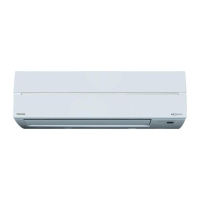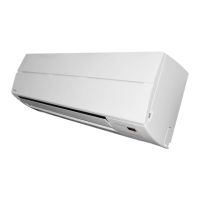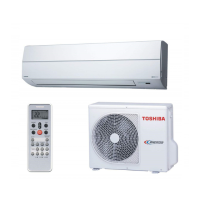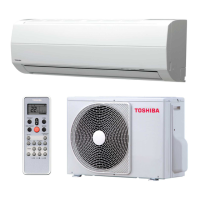Do you have a question about the Toshiba RAS-18SAV2-E and is the answer not in the manual?
Explains safety symbols, marks, and R410A installation precautions.
Covers power disconnection, electrical safety, and installation dangers.
Provides detailed specifications for indoor and outdoor units.
Graphs showing compressor speed, current, and capacity variation.
Essential safety precautions for handling R410A refrigerant during installation and servicing.
Details piping installation, materials, joints, processing, and required tools for R410A.
Covers refrigerant recharging, charging notes, and brazing methods/materials.
Exploded view and dimensions of the indoor unit.
Exploded view, dimensions, and installation dimensions of the outdoor unit.
Provides wiring diagrams for different indoor and outdoor unit model combinations.
Lists electrical component specifications for both indoor and outdoor units.
Diagrams showing the refrigerant flow for different indoor/outdoor unit models.
Provides cooling and heating operation data based on temperature conditions.
Block diagrams illustrating the control systems of the indoor and outdoor units.
Overview of the air conditioner's control system, controllers, and signal communication.
Covers basic operation, fan control, capacity, protective functions, special modes, and remote control.
Configuration and management of the auto-restart function.
Information about remote control functions, operation, and display indicators.
Explains the indoor unit's display and operation panel controls.
Illustrates placement and spacing for indoor and outdoor unit installation.
Lists optional parts and tools for installation.
Details included accessories and installation parts.
Highlights tool changes required for R410A compared to R22.
Instructions for selecting indoor unit location, cutting holes, piping, drainage, and wiring.
Instructions for direct mounting, wall mounting, and concealed installation.
Guidelines for outdoor unit placement and precautions for cold climates.
Procedures for connecting refrigerant piping using flaring.
Procedures for system evacuation and electrical wiring.
Performing gas leak tests and setting up remote control modes.
General troubleshooting approach and safety precautions for the inverter.
Safety measures when inspecting the outdoor unit's control section, including capacitor discharging.
Steps for confirming power, voltage, and normal program operation.
Methods for initial troubleshooting and interpretation of indoor unit LED flashing codes.
Procedure for using the remote controller in service mode for self-diagnosis.
Detailed table of check codes, causes, and recommended troubleshooting actions.
Further troubleshooting actions for inverter, sensor, and fan motor errors.
Troubleshooting for serial signal errors, compressor issues, and temperature sensor faults.
Diagnosing problems related to indoor unit power and PC board defects.
Diagnosing issues with the indoor fan motor operation.
Diagnosing why the indoor fan motor might rotate automatically on power-up.
Diagnosing common problems related to the remote control and its communication.
Troubleshooting issues related to interconnecting and serial signal wiring between units.
Diagnosing miswiring and specific sensor errors (1C, 1E).
Summarized inner diagnosis of the outdoor unit inverter assembly.
Procedures for checking the indoor PC board and its components for defects.
Detailed check procedures for PC board components and compressor.
PC board layout diagram and sensor resistance vs. temperature table.
Resistance checks for various indoor and outdoor unit components like motors and coils.
Checking methods for capacitors, diodes, and temperature sensors.
Simple method to determine if the outdoor fan motor is good or bad.
Safety warnings and general procedures before replacing parts.
Step-by-step guide to replace the indoor unit's electrical parts box.
Procedures for replacing the indoor unit's heat exchanger and horizontal louver.
Procedures for replacing the indoor unit's louver base and bell mouth.
Procedures for replacing the indoor unit's turbo fan and fan motor.
Procedure for replacing the indoor unit's microcomputer and related components.
Procedures for detaching and attaching the outdoor unit's cabinet and water-proof cover.
Procedures for detaching and attaching the outdoor unit's front cabinet.
Procedures for replacing the outdoor unit's inverter assembly, including safety precautions.
Procedures for replacing the outdoor unit's control board assembly.
Procedures for replacing the outdoor unit's side cabinets and fan motor.
Procedures for replacing the outdoor unit's compressor and reactor.
Procedures for replacing the expansion valve coil and fan guard.
Procedures for replacing various temperature sensors.
Details on common service parts for sensor replacement.
Exploded view and parts list for the indoor unit.
Exploded view and parts list for indoor unit E-parts.
Exploded view and parts list for the outdoor unit (RAS-10,13SAV2-E).
Exploded view and parts list for the outdoor unit (RAS-18SAV2-E).
Exploded view and parts list for the PC board (RAS-10, 13SAV2-E).
Exploded view and parts list for the PC board (RAS-18SAV2-E).
Exploded view and parts list for the PC board (RAS-18SAV-E).
| Brand | Toshiba |
|---|---|
| Model | RAS-18SAV2-E |
| Category | Air Conditioner |
| Language | English |











